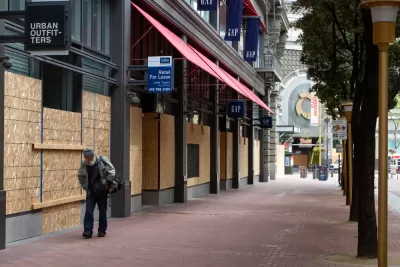The pandemic is accelerating recent trends in commercial real estate with potentially catastrophic consequences for the commercial corridors that play such a fundamental role in the urban fabric.

An article by Jorge González and Jein Park checks in with the state of commercial corridors, which the article calls the "backbone of neighborhoods."
Despite their centrality to so many neighborhoods commercial corridors are dealing with major destabilizing forces, and according to the article that destabilization reaches far beyond the businesses owners effected by the economic effects of the pandemic. " Increased storefront vacancies not only indicate economic hardship for property owners, businesses, and local governments (through reduced fiscal revenues), but they also affect the surrounding communities," write González and Park.
The article identifies one critical trend: The pandemic is accelerating a decade-long trend of rising retail vacancies.
Today, Yelp data show permanent business closures have increased steadily since the pandemic began, and as of September, 60 percent of the 160,000 closures registered in the platform were permanent. The hardest-hit businesses are restaurants, retail stores, beauty stores and spas, bars and nightlife venues, and fitness venues—key components of commercial corridors.
The negative effects of vacancies (e.g., reduce property values, fire risk, crime, and negative health effects) can be mitigated by local governments, according to the article, even if the federal government never puts together a second round of economic stimulus. Among the suggested prescriptions for the economic downturn for commercial corridors during the pandemic, the article suggests grants and loans, repurposing of public spaces previously devoted to automobiles, relaxed zoning and permitting, and public art programs, vacancy taxes, and more.
Each recommendation includes more detail in the source article.
FULL STORY: Local Policies Can Protect Commercial Corridors as the Pandemic Continues

Alabama: Trump Terminates Settlements for Black Communities Harmed By Raw Sewage
Trump deemed the landmark civil rights agreement “illegal DEI and environmental justice policy.”

Study: Maui’s Plan to Convert Vacation Rentals to Long-Term Housing Could Cause Nearly $1 Billion Economic Loss
The plan would reduce visitor accommodation by 25% resulting in 1,900 jobs lost.

Why Should We Subsidize Public Transportation?
Many public transit agencies face financial stress due to rising costs, declining fare revenue, and declining subsidies. Transit advocates must provide a strong business case for increasing public transit funding.

Paris Bike Boom Leads to Steep Drop in Air Pollution
The French city’s air quality has improved dramatically in the past 20 years, coinciding with a growth in cycling.

Why Housing Costs More to Build in California Than in Texas
Hard costs like labor and materials combined with ‘soft’ costs such as permitting make building in the San Francisco Bay Area almost three times as costly as in Texas cities.

San Diego County Sees a Rise in Urban Coyotes
San Diego County experiences a rise in urban coyotes, as sightings become prevalent throughout its urban neighbourhoods and surrounding areas.
Urban Design for Planners 1: Software Tools
This six-course series explores essential urban design concepts using open source software and equips planners with the tools they need to participate fully in the urban design process.
Planning for Universal Design
Learn the tools for implementing Universal Design in planning regulations.
Smith Gee Studio
Alamo Area Metropolitan Planning Organization
City of Santa Clarita
Institute for Housing and Urban Development Studies (IHS)
City of Grandview
Harvard GSD Executive Education
Toledo-Lucas County Plan Commissions
Salt Lake City
NYU Wagner Graduate School of Public Service





























